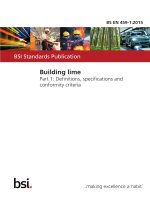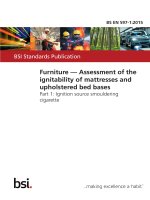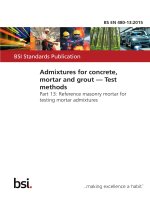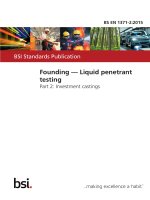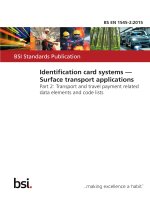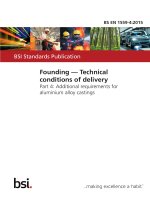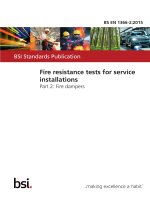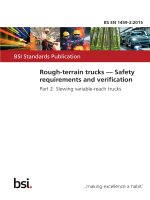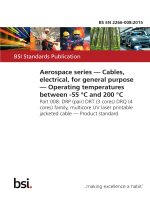Bsi bs en 62053 24 2015
Bạn đang xem bản rút gọn của tài liệu. Xem và tải ngay bản đầy đủ của tài liệu tại đây (1.38 MB, 32 trang )
BS EN 62053-24:2015
BSI Standards Publication
Electricity metering
equipment (a.c.) —
Particular requirements
Part 24: Static meters for reactive
energy at fundamental frequency
(classes 0,5 S, 1 S and 1)
BRITISH STANDARD
BS EN 62053-24:2015
National foreword
This British Standard is the UK implementation of EN 62053-24:2015. It is
identical to IEC 62053-24:2014.
The UK participation in its preparation was entrusted to Technical
Committee PEL/13, Electricity Meters.
A list of organizations represented on this committee can be obtained on
request to its secretary.
This publication does not purport to include all the necessary provisions of
a contract. Users are responsible for its correct application.
© The British Standards Institution 2015.
Published by BSI Standards Limited 2015
ISBN 978 0 580 71816 8
ICS 17.220.20; 91.140.50
Compliance with a British Standard cannot confer immunity from
legal obligations.
This British Standard was published under the authority of the
Standards Policy and Strategy Committee on 31 January 2015.
Amendments/corrigenda issued since publication
Date
Text affected
BS EN 62053-24:2015
EUROPEAN STANDARD
EN 62053-24
NORME EUROPÉENNE
EUROPÄISCHE NORM
January 2015
ICS 17.220.20; 91.140.50
English Version
Electricity metering equipment (a.c.) - Particular requirements Part 24: Static meters for reactive energy at fundamental
frequency (classes 0,5 S, 1 S and 1)
(IEC 62053-24:2014)
Équipement de comptage de l'électricité (c.a.) - Exigences
particulières - Partie 24: Compteurs statiques d'énergie
réactive à la fréquence fondamentale
(classes 0,5 S, 1 S et 1)
(IEC 62053-24:2014)
Wechselstrom-Elektrizitätszähler - Besondere
Anforderungen - Teil 24: Elektronische GrundschwingungsBlindverbrauchszähler
der Genauigkeitsklassen 0,5 S, 1 S und 1
(IEC 62053-24:2014)
This European Standard was approved by CENELEC on 2014-07-24. CENELEC members are bound to comply with the CEN/CENELEC
Internal Regulations which stipulate the conditions for giving this European Standard the status of a national standard without any alteration.
Up-to-date lists and bibliographical references concerning such national standards may be obtained on application to the CEN-CENELEC
Management Centre or to any CENELEC member.
This European Standard exists in three official versions (English, French, German). A version in any other language made by translation
under the responsibility of a CENELEC member into its own language and notified to the CEN-CENELEC Management Centre has the
same status as the official versions.
CENELEC members are the national electrotechnical committees of Austria, Belgium, Bulgaria, Croatia, Cyprus, the Czech Republic,
Denmark, Estonia, Finland, Former Yugoslav Republic of Macedonia, France, Germany, Greece, Hungary, Iceland, Ireland, Italy, Latvia,
Lithuania, Luxembourg, Malta, the Netherlands, Norway, Poland, Portugal, Romania, Slovakia, Slovenia, Spain, Sweden, Switzerland,
Turkey and the United Kingdom.
European Committee for Electrotechnical Standardization
Comité Européen de Normalisation Electrotechnique
Europäisches Komitee für Elektrotechnische Normung
CEN-CENELEC Management Centre: Avenue Marnix 17, B-1000 Brussels
© 2015 CENELEC All rights of exploitation in any form and by any means reserved worldwide for CENELEC Members.
Ref. No. EN 62053-24:2015 E
BS EN 62053-24:2015
EN 62053-24:2015
-2-
Foreword
The text of document 13/1569/FDIS, future edition 1 of IEC 62053-24, prepared by
IEC/TC 13 "Electrical energy measurement and control" was submitted to the IEC-CENELEC parallel
vote and approved by CENELEC as EN 62053-24:2015.
The following dates are fixed:
•
latest date by which the document has to be
implemented at national level by
publication of an identical national
standard or by endorsement
(dop)
2015-07-16
•
latest date by which the national
standards conflicting with the
document have to be withdrawn
(dow)
2017-07-24
Attention is drawn to the possibility that some of the elements of this document may be the subject of
patent rights. CENELEC [and/or CEN] shall not be held responsible for identifying any or all such
patent rights.
This document has been prepared under a mandate given to CENELEC by the European Commission
and the European Free Trade Association, and supports essential requirements of EU Directive.
For the relationship with EU Directive see informative Annex ZZ, which is an integral part of this
document.
Endorsement notice
The text of the International Standard IEC 62053-24:2014 was approved by CENELEC as a European
Standard without any modification.
In the official version, for Bibliography, the following notes have to be added for the standards indicated:
IEC 61869-2:2012
NOTE
Harmonized as EN 61869-2:2012 (not modified).
IEC 62053-21:2003
NOTE
Harmonized as EN 62053-21:2003 (not modified).
IEC 62053-23:2003
NOTE
Harmonized as EN 62053-23:2003 (not modified).
IEC 62053-61:1998
NOTE
Harmonized as EN 62053-61:1998 (not modified).
BS EN 62053-24:2015
EN 62053-24:2015
-3-
Annex ZA
(normative)
Normative references to international publications
with their corresponding European publications
The following documents, in whole or in part, are normatively referenced in this document and are
indispensable for its application. For dated references, only the edition cited applies. For undated
references, the latest edition of the referenced document (including any amendments) applies.
NOTE 1 When an International Publication has been modified by common modifications, indicated by (mod), the relevant
EN/HD applies.
NOTE 2 Up-to-date information on the latest versions of the European Standards listed in this annex is available here:
www.cenelec.eu
Publication
Year
Title
EN/HD
Year
IEC 62052-11
2003
Electricity metering equipment (AC) General requirements, tests and test
conditions Part 11: Metering equipment
EN 62052-11
2003
BS EN 62053-24:2015
EN 62053-24:2015
-4-
Annex ZZ
(informative)
Coverage of Essential Requirements of EU Directives
This European Standard has been prepared under a mandate given to CENELEC by the European
Commission and the European Free Trade Association and within its scope this standard covers all
relevant essential requirements as given in Annex I of the EU Directive 2004/108/EC.
Compliance with this standard provides one means of conformity with the specified essential
requirements of the Directive concerned.
WARNING: Other requirements and other EU Directives can be applied to the products falling within
the scope of this standard.
–2–
BS EN 62053-24:2015
IEC 62053-24:2014 © IEC 2014
CONTENTS
INTRODUCTION ..................................................................................................................... 6
1
Scope .............................................................................................................................. 7
2
Normative references ...................................................................................................... 7
3
Terms and definitions ...................................................................................................... 8
4
Standard electrical values ............................................................................................... 8
5
Mechanical requirements ................................................................................................. 8
6
Climatic conditions .......................................................................................................... 8
7
Electrical requirements .................................................................................................... 8
7.1
General ................................................................................................................... 8
7.2
Power consumption................................................................................................. 9
7.2.1
General ........................................................................................................... 9
7.2.2
Voltage circuits ................................................................................................ 9
7.2.3
Current circuits ................................................................................................ 9
Influence of short-time overcurrents ........................................................................ 9
7.3
7.4
Influence of self-heating ........................................................................................ 10
7.5
AC voltage test ..................................................................................................... 11
8
Accuracy requirements .................................................................................................. 11
8.1
General ................................................................................................................. 11
8.2
Limits of error due to variation of the current ......................................................... 11
8.3
Limits of error due to influence quantities .............................................................. 12
8.3.1
General ......................................................................................................... 12
8.3.2
Tests of the influence of DC and even harmonics in the current circuit .......... 14
8.3.3
Continuous magnetic induction of external origin ........................................... 14
8.3.4
Harmonics ..................................................................................................... 14
Test of starting and no-load condition ................................................................... 15
8.4
8.4.1
General ......................................................................................................... 15
8.4.2
Initial start-up of the meter ............................................................................. 15
8.4.3
Test of no-load condition ............................................................................... 15
8.4.4
Starting.......................................................................................................... 16
Meter constant ...................................................................................................... 16
8.5
8.6
Accuracy test conditions ....................................................................................... 16
8.7
Interpretation of test results .................................................................................. 17
Annex A (normative) Test circuit diagram for DC and even harmonics ................................. 18
Annex B (normative) Electromagnet for testing the influence of externally produced
magnetic fields ..................................................................................................................... 20
Annex C (informative) Geometric representation of active and reactive power ..................... 21
Annex D (informative) Effect of phase displacement ............................................................ 23
Phase displacement and matching of current transformers and meters for
reactive energy ..................................................................................................... 23
Annex E (informative) Treatment of harmonics and tests for harmonics ............................... 24
D.1
Non-sinusoidal conditions and reactive power definition ........................................ 24
Tests for accuracy under non-sinusoidal conditions .............................................. 24
Fifth harmonic test ................................................................................................ 25
Bibliography .......................................................................................................................... 26
E.1
E.2
E.3
BS EN 62053-24:2015
IEC 62053-24:2014 © IEC 2014
–3–
Figure A.1 – Test circuit diagram for half-wave rectification .................................................. 18
Figure A.2 – Half-wave rectified waveform ............................................................................ 19
Figure B.1 – Electromagnet for testing the influence of externally produced magnetic
fields..................................................................................................................................... 20
Figure C.1 – Recommended geometric representation .......................................................... 21
Figure C.2 – Alternative geometric representation ................................................................ 22
Table 1 – Power consumption in voltage circuits for single-phase and polyphase
meters including the power supply .......................................................................................... 9
Table 2 – Power consumption in current circuits ..................................................................... 9
Table 3 – Variations due to short-time overcurrents .............................................................. 10
Table 4 – Variations due to self-heating ................................................................................ 10
Table 5 – AC voltage tests .................................................................................................... 11
Table 6 – Percentage error limits (single-phase meters and polyphase meters with
balanced loads) .................................................................................................................... 12
Table 7 – Percentage error limits (polyphase meters carrying a single-phase load, but
with balanced polyphase voltages applied to voltage circuits) ............................................... 12
Table 8 – Influence quantities ............................................................................................... 13
Table 9 – Starting current ..................................................................................................... 16
Table 10 – Voltage and current balance ................................................................................ 16
Table 11 – Reference conditions ........................................................................................... 17
Table 12 – Interpretation of test results ................................................................................. 17
Table D.1 – Limits of phase displacement for measuring current transformers and
corresponding measurement error for reactive energy measurement .................................... 23
–6–
BS EN 62053-24:2015
IEC 62053-24:2014 © IEC 2014
INTRODUCTION
This part of IEC 62053 is to be used with the following relevant parts of the IEC 62052,
IEC 62053 and IEC 62059 series, Electricity metering equipment:
IEC 62052-11:2003, Electricity metering equipment (a.c.) – General requirements, tests and
test conditions – Part 11: Metering equipment
IEC 62053-21:2003, Electricity metering equipment (a.c.) – Particular requirements – Part 21:
Static meters for active energy (classes 1 and 2)
IEC 62053-22:2003, Electricity metering equipment (a.c.) – Particular requirements – Part 22:
Static meters for active energy (classes 0,2 S and 0,5 S)
IEC 62053-31:1998, Electricity metering equipment (a.c.) – Particular requirements – Part 31:
Pulse output devices for electromechanical and electronic meters (two wires only)
IEC 62053-52:2005, Electricity metering equipment (a.c.) – Particular requirements – Part 52:
Symbols
IEC 62053-61:1998, Electricity metering equipment (a.c.) – Particular requirements – Part 61:
Power consumption and voltage requirements
IEC 62059-11:2002, Electricity metering equipment (a.c.) – Dependability – Part 11: General
concepts
IEC 62059-21:2002, Electricity metering equipment (a.c.) – Dependability – Part 21:
Collection of meter dependability data from the field
IEC 62059-31-1:2008, Electricity metering equipment – Dependability –Part 31-1: Accelerated
reliability testing – Elevated temperature and humidity
IEC 62059-32-1:2011, Electricity metering equipment – Dependability – Part 32-1: Durability –
Testing of the stability of metrological characteristics by applying elevated temperature
IEC 62059-41:2006, Electricity metering equipment – Dependability – Part 41: Reliability
prediction
This part is a standard for type testing electricity meters. It covers the particular requirements
for meters, used indoors and outdoors. It does not deal with special implementations (such as
metering-part and/or displays in separate housings).
This standard is intended to be used in conjunction with IEC 62052-11. When any requirement
in this standard concerns an item already covered in IEC 62052-11, the requirements of this
standard take precedence over the requirements of IEC 62052-11.
This standard distinguishes:
•
between transformer operated meters of accuracy class index 0,5 S and 1 S and direct
connected meters of accuracy class index 1;
•
between protective class I and protective class II meters;
•
between meters for use in networks equipped with or without earth fault neutralizers.
The test levels are regarded as minimum values that provide for the proper functioning of the
meter under normal working conditions. For special application, other test levels might be
necessary and should be agreed on between the user and the manufacturer.
BS EN 62053-24:2015
IEC 62053-24:2014 © IEC 2014
–7–
ELECTRICITY METERING EQUIPMENT (a.c.) –
PARTICULAR REQUIREMENTS –
Part 24: Static meters for reactive energy at fundamental frequency
(classes 0,5 S, 1 S and 1)
1
Scope
This part of IEC 62053 applies only to newly manufactured transformer operated static varhour meters of accuracy classes 0,5 S, and 1 S as well as direct connected static var-hour
meters of accuracy class 1, for the measurement of alternating current electrical reactive
energy in 50 Hz or 60 Hz networks and it applies to their type tests only.
This standard uses a conventional definition of reactive energy where the reactive power and
energy is calculated from the fundamental frequency components of the currents and voltages
only. See Clause 3.
NOTE 1 This differs from the approach of IEC 62053-23, where reactive power and energy is defined only for
sinusoidal signals. In this standard reactive power and energy is defined for all periodic signals. Reactive power
and energy is defined in this way to achieve proper reproducibility of measurements with meters of different
designs. With this definition, reactive power and energy reflects the generally unnecessary current possible to
compensate with capacitors rather than the total unnecessary current.
It applies only to static var-hour meters for indoor and outdoor application consisting of a
measuring element and register(s) enclosed together in a meter case. It also applies to
operation indicator(s) and test output(s). If the meter has a measuring element for more than
one type of energy (multi-energy meters), or when other functional elements, like maximum
demand indicators, electronic tariff registers, time switches, ripple control receivers, data
communication interfaces, etc., are enclosed in the meter case, then the relevant standards
for these elements also apply.
NOTE 2 IEC 61869-2:2012 describes transformers having a measuring range of 0,05 I n to I max for accuracy
classes 0,2, 0,5, 1 and 2, and transformers having a measuring range of 0,01 I n to I max for accuracy classes 0,2 S
and 0,5 S. As the measuring range of a meter and its associated transformers have to be matched and as only
transformers of classes 0,2 S / 0,5 S have the current error and phase displacement characteristics suitable to
operate a class 0,5 S / 1 S meter respectively as specified in this standard, the measuring range of the transformer
operated meters will be 0,01 I n to I max. Reactive meters intended to be used together with non-S transformers are,
therefore, not covered by this standard.
It does not apply to:
•
var-hour meters where the voltage across the connection terminals exceeds 600 V (lineto-line voltage for meters for polyphase systems);
•
portable meters;
•
data interfaces to the register of the meter;
•
reference meters.
The dependability aspect is covered by the standards of the IEC 62059 series.
2
Normative references
The following documents, in whole or in part, are normatively referenced in this document and
are indispensable for its application. For dated references, only the edition cited applies. For
undated references, the latest edition of the referenced document (including any
amendments) applies.
–8–
BS EN 62053-24:2015
IEC 62053-24:2014 © IEC 2014
IEC 62052-11:2003, Electricity metering equipment (a.c.) – General requirements, tests and
test conditions – Part 11: Metering equipment
3
Terms and definitions
For the purposes of this document, the terms and definitions given in IEC 62052-11 apply with
the following exception:
3.1
reactive power
Q
reactive power Q in a single phase system is defined for steady-state and periodic signals as
Q = U 1 ∗ I1 ∗ sin ϕ1
where U 1 and I 1 are the r.m.s. values of the fundamental frequency components of the
voltage and the current respectively, and
φ 1 is the phase angle between them. The reactive power in poly-phase system is the
algebraic sum of the per-phase reactive powers:
Q = U L1 ∗ I L1 ∗ sin ϕ L1 + U L 2 ∗ I L 2 ∗ sin ϕ L 2 + .....
where
L1 and L2 are the first and second phase of the system.
Note 1 to entry:
For direction of flow and sign of reactive power, see Annex C.
Note 2 to entry: The actual algorithm used for the calculation of reactive power is not of importance as long as the
meter meets requirements of this standard. See also Annex E.
Note 3 to entry: While meters for active energy have to measure active energy including harmonic components,
reactive energy meters according to this standard have to measure fundamental component reactive energy, with
minimum influence from harmonics.
4
Standard electrical values
The values given in IEC 62052-11 apply.
5
Mechanical requirements
The requirements of IEC 62052-11 apply.
6
Climatic conditions
The conditions given in IEC 62052-11 apply.
7
7.1
Electrical requirements
General
In addition to the electrical requirements in IEC 62052-11, meters shall fulfil the following
requirements.
BS EN 62053-24:2015
IEC 62053-24:2014 © IEC 2014
7.2
–9–
Power consumption
7.2.1
General
The power consumption in the voltage and current circuit shall be determined at reference
values of the influence quantities given in 8.6 by any suitable method. The overall uncertainty
of the measurement of the power consumption shall not exceed 5 %.
7.2.2
Voltage circuits
The active and apparent power consumption in each voltage circuit of a meter at reference
voltage, reference temperature and reference frequency shall not exceed the values shown in
Table 1.
Table 1 – Power consumption in voltage circuits for single-phase
and polyphase meters including the power supply
Meters
Voltage circuit
Power supply connected
to the voltage circuits
Power supply not connected
to the voltage circuits
2 W and 10 VA
0,5 VA
–
10 VA
Auxiliary power supply
NOTE 1 In order to match voltage transformers to meters, the meter manufacturer should state whether the
burden is inductive or capacitive (for transformer operated meters only).
NOTE 2 The above figures are mean values. Switching power supplies with peak values in excess of these
specified values are permitted, but it should be ensured that the rating of associated voltage transformers is
adequate.
NOTE 3
7.2.3
For multifunctional meters, see IEC 62053-61.
Current circuits
The apparent power taken by each current circuit of a direct connected meter at basic current,
reference frequency and reference temperature shall not exceed the values shown in Table 2.
The apparent power taken by each current circuit of a meter connected through a current
transformer shall not exceed the value shown in Table 2, at a current value that equals the
rated secondary current of the corresponding transformer, at reference temperature and
reference frequency of the meter.
Table 2 – Power consumption in current circuits
Meters
Single-phase and polyphase direct connected meter
Single-phase and polyphase transformer operated meters
Class of meter
0,5 S
1S
1
–
–
4,0 VA
1,0 VA
1,0 VA
–
NOTE 1 The rated secondary current is the value of the secondary current indicated on the current transformer,
on which the performance of the transformer is based. Standard values of maximum secondary current are
120 %, 150 % and 200 % of the rated secondary current.
NOTE 2 In order to match current transformers to meters, the meter manufacturer should state whether the
burden is inductive or capacitive (for transformer operated meters only).
7.3
Influence of short-time overcurrents
Short-time overcurrents shall not damage the meter. The meter shall perform correctly when
back to its initial working condition and the variation of error shall not exceed the values
shown in Table 3.
BS EN 62053-24:2015
IEC 62053-24:2014 © IEC 2014
– 10 –
The test circuit shall be practically non-inductive and the test shall be performed for
polyphase meters phase-by-phase.
After the application of the short-time overcurrent with the voltage maintained at the terminals,
the meter shall be allowed to return to the initial temperature with the voltage circuit(s)
energized (about 1 h).
a) Meter for direct connection
The meter shall be able to carry a short-time overcurrent of 30 I max (r.m.s.) with a relative
tolerance of +0 % to –10 % for one half-cycle of a sinusoidal waveforms starting at zero
volt, at rated frequency.
b) Meter for connection through current transformer
The meter shall be able to carry for 0,5 s a sinusoidal current at rated frequency equal to
20 I max with a relative tolerance of +0 % to –10 %.
This requirement does not apply to meters having a switch in the current circuits. For this
case, see appropriate standards.
Table 3 – Variations due to short-time overcurrents
Meters for
Value of current
Limits of variations in percentage
error for meters of class
sin ϕ
(inductive or
capacitive)
0,5 S
1S
1
Direct connection
Ib
1
–
–
1,5
Connection through
current
transformers
In
1
0,1
0,1
–
7.4
Influence of self-heating
The variation of error due to self-heating shall not exceed the values given in Table 4.
Table 4 – Variations due to self-heating
Value of current
I max
sin ϕ
(inductive or capacitive)
Limits of variations in percentage
error for meters of class
0,5 S
1 S or 1
1
0,2
0,7
0,5
0,2
1,0
The test shall be carried out as follows: After the voltage circuits have been energized at
reference voltage for at least 1 h, without any current in the current circuits, the maximum
current shall be applied to the current circuits. The meter error shall be measured at sin ϕ = 1
immediately after the current is applied and then at intervals short enough to allow a correct
drawing to be made of the curve of error variation as a function of time. The test shall be
carried out for at least 1 h, and in any event until the variation of error during 20 min does not
exceed 0,1 % for class 1 S and class 1 meters and 0,05 % for a class 0,5 S meter.
For this test, the percentage error of the meter shall be measured at sin φ = 1 and sin φ = 0,5
inductive or capacitive with minimum interruptions for changing the measurement point.
The cable to be used for energizing the meter shall have a length of 1 m. For meters with
I max > 6 A, the cable cross-section shall ensure that the current density is between 3,2 A/mm 2
and 4 A/mm 2 . For meters with an I max ≤ 6 A, a cross-section in accordance with the meter
specification shall be used.
BS EN 62053-24:2015
IEC 62053-24:2014 © IEC 2014
7.5
– 11 –
AC voltage test
The a.c. voltage test shall be carried out in accordance with Table 5.
The test voltage shall be substantially sinusoidal, having a frequency between 45 Hz and
65 Hz, and applied for 1 min. The power source shall be capable of supplying at least 500 VA.
During the tests relative to earth, the auxiliary circuits with reference voltage equal to or
below 40 V shall be connected to earth.
All these tests shall be carried out with the case closed and the cover and terminal covers in
place.
During this test, no flashover, disruptive discharge or puncture shall occur.
Table 5 – AC voltage tests
Test
A
Applicable to
Protective
class I meters
Test voltage r.m.s
Points of application of the test voltage
a)
Between, on the one hand, all the current and voltage
circuits as well as the auxiliary circuits whose reference
voltage is over 40 V, connected together, and, on the
other hand, earth
b)
Between circuits not intended to be connected together in
service
a)
Between, on the one hand, all the current and voltage
circuits as well as the auxiliary circuits whose reference
voltage is over 40 V, connected together, and, on the
other hand, earth
b)
Between circuits not intended to be connected together in
service
c)
A visual inspection for compliance with the conditions of
5.7 of IEC 62052-11:2003.
2 kV
2 kV
4 kV
B
Protective
class II meters
2 kV
–
8
8.1
Accuracy requirements
General
The tests and test conditions given in IEC 62052-11 apply.
8.2
Limits of error due to variation of the current
When the meter is under the reference conditions given in 8.6, the percentage errors shall not
exceed the limits for the relevant accuracy class given in Table 6 and Table 7.
BS EN 62053-24:2015
IEC 62053-24:2014 © IEC 2014
– 12 –
Table 6 – Percentage error limits (single-phase meters
and polyphase meters with balanced loads)
Value of current
for direct connected
meters
a)
for transformer
operated (S) meters
a)
Percentage error limits
for meters of class
sin ϕ
(inductive or
capacitive)
0,5 S a)
1 S a)
1
0,05 I b ≤ I < 0,1 I b
0,01 I n ≤ I < 0,05 I n
1
±1,0
±1,5
±1,5
0,1 I b ≤ I ≤ I max
0,05 I n ≤ I ≤ I max
1
±0,5
±1,0
±1,0
0,1 I b ≤ I < 0,2 I b
0,05 I n ≤ I < 0,1 I n
0,5
±1,0
±1,5
±1,5
0,2 I b ≤ I ≤ I max
0,1 I n ≤ I ≤ I max
0,5
±0,5
±1,0
±1,0
0,2 I b ≤ I ≤ I max
0,1 I n ≤ I ≤ I m ax
0,25
±1,0
±2,0
±2,0
It is recommended that current transformers of accuracy class 0,2 S / 0,5 S are used with meters of accuracy
class 0,5 S / 1 S respectively in order to keep the overall system error – due to the phase displacement – on
a low level.
Table 7 – Percentage error limits (polyphase meters carrying a single-phase load,
but with balanced polyphase voltages applied to voltage circuits)
Value of current
Percentage error limits
for meters of class
sin ϕ
(inductive or
capacitive)
0,5 S a)
1 or 1 S a)
for direct connected
meters
for transformer
operated (S) meters a)
0,1 I b ≤ I ≤ I max
0,05 I n ≤ I ≤ I max
1
± 0,7
± 1,5
0,2 I b ≤ I ≤ I max
0,1 I n ≤ I ≤ I max
0,5
± 1,0
± 2,0
0,2 I b ≤ I ≤ I max
0,1 I n ≤ I ≤ I max
0,25
± 1,5
± 3,0
a)
It is recommended that current transformers of accuracy class 0,2 S / 0,5 S are used with meters of accuracy
class 0,5 S / 1 S respectively in order to keep the overall system error – due to the phase displacement – on
a low level.
The difference between the percentage error when the meter is carrying a single-phase load
and a balanced polyphase load at basic current I b and sin ϕ = 1 for direct connected meters,
shall not exceed 1,5 % for meters of class 1. At rated current I n and sin ϕ = 1 for transformer
operated meters, the difference shall not exceed 0,7 % and 1,5 % for meters of classes 0,5 S
and 1 S respectively.
When testing for compliance with Table 7, the test current should be applied to each
measuring element in sequence.
8.3
8.3.1
Limits of error due to influence quantities
General
The additional percentage error due to the change of influence quantities with respect to
reference conditions, as given in 8.6, shall not exceed the limits for the relevant accuracy
class given in Table 8.
BS EN 62053-24:2015
IEC 62053-24:2014 © IEC 2014
– 13 –
Table 8 – Influence quantities
Value of current (balanced
unless otherwise stated)
Influence quantity
Ambient temperature variation
7)
for direct
connected
meters
for transformeroperated meters
sin ϕ
(inductive
or
capacitive)
0,1 I b ≤ I ≤ I max
0,05 I n ≤ I ≤ I max
0,2 I b ≤ I ≤ I max
0,1 I n ≤ I ≤ I max
Mean temperature
coefficient %/K for
meters of class
0,5 S
1 or 1 S
1
0,03
0,05
0,5
0,05
0,10
Limits of variation
in percentage error
for meters of class
Voltage variation ±10 %
1) 2)
Frequency variation±2 %
2)
Harmonic components in the
current and voltage circuits 9)
DC and even harmonics in the
current circuit 3)
0,5 S
1 or 1 S
0,05 I b ≤ I ≤ I max
0,02 I n ≤ I ≤ I max
1
0,25
0,5
0,1 I b ≤ I ≤ I max
0,05 I n ≤ I ≤ I max
0,5
0,5
1,0
0,05 I b ≤ I ≤ I max
0,02 I n ≤ I ≤ I max
1
0,5
1,0
0,1 I b ≤ I ≤ I max
0,05 I n ≤ I ≤ I max
0,5
0,5
1,0
Ib
I max/2
1
2,5
2,5
–
1
–
6,0
I max
2
Continuous magnetic induction of
external origin 4)
Ib
In
1
2,0
2,0
Magnetic induction of external
origin 0,5 mT 5)
Ib
In
1
1,0
2,0
Electromagnetic RF fields
Ib
In
1
2,0
2,0
0,05 I b
0,05 I n
1
0,5
0,5
Conducted disturbances, induced
by radio-frequency fields
Ib
In
1
1,5
2,5
Fast transient burst
Ib
In
1
2,0
3,0
Damped oscillatory waves
immunity 8)
–
In
1
2,0
3,0
Operation of accessories
6)
– 14 –
BS EN 62053-24:2015
IEC 62053-24:2014 © IEC 2014
1)
For the voltage ranges from –20 % to –10 % and +10 % to +15 %, the limits of variation in percentage errors
are three times the values given in this Table.
Below 0,8 U n the error of the meter may vary between +10 % and –100 %.
2)
The recommended test point for voltage variation and frequency variation is I b for direct connected meters
and I n for transformer operated meters.
3)
The purpose of this test is to check for current sensor saturation only. The test conditions are specified in
8.3.2 and in Annex A. The distortion factor of the voltage shall be less than 1 %. This test is not applicable for
transformer operated meters.
4)
The test conditions are specified in 8.3.3.
5)
A magnetic induction of external origin of 0,5 mT produced by a current of the same frequency as that of the
voltage applied to the meter and under the most unfavourable conditions of phase and direction shall not
cause a variation in the percentage error of the meter exceeding the values shown in this Table.
The magnetic induction shall be obtained by placing the meter in the centre of a circular coil, 1 m in mean
diameter, of square section and of small radial thickness relative to the diameter, and having 400 At.
6)
Such an accessory, when enclosed in the meter case, is energized intermittently, for example the
electromagnet of a multi-rate register.
It is preferable that the connection to the auxiliary device(s) is marked to indicate the correct method of
connection. If these connections are made by means of plugs and sockets, they should not be
interchangeable.
7)
The mean temperature coefficient shall be determined for the whole operating range. The operating
temperature range shall be divided into 20 K wide ranges. The mean temperature coefficient shall then be
determined for these ranges, by taking measurements10 K above and 10 K below the middle of the range.
During the test, the temperature shall be in no case outside the specified operating temperature range.
8)
See IEC 62052-11:2003, 7.5.7.
9)
The test conditions are specified in 8.3.4.
Tests for variation caused by influence quantities should be performed independently with all
other influence quantities at their reference conditions (see Table 11).
8.3.2
Tests of the influence of DC and even harmonics in the current circuit
This test applies only for direct connected meters.
The tests of the influence of DC and even harmonics in the current circuit shall be made with
the circuit shown in Figure A.1 or with other equipment able to generate the required waveforms, and the current wave-forms as shown in Figure A.2.
The variation in percentage error when the meter is subjected to the test wave-form given in
Figure A.2 and when it is subjected to the reference wave-form shall not exceed the limits of
variation given in Table 8.
The values given in Figure A.2 are for 50 Hz only. For other frequencies the values have to be
adapted accordingly.
8.3.3
Continuous magnetic induction of external origin
The continuous magnetic induction may be obtained by using the electromagnet according to
Annex B, energized with a d.c. current. This magnetic field shall be applied to all accessible
surfaces of the meter when it is mounted as for normal use. The value of the magneto-motive
force applied shall be 1 000 At (ampere-turns).
8.3.4
Harmonics
This test is to verify that harmonics do not influence the measurements more than what is
given in Table 8.
Test conditions:
BS EN 62053-24:2015
IEC 62053-24:2014 â IEC 2014
ã
ã
ã
ã
15
fundamental frequency current (I 1 ): see Table 8;
fundamental frequency voltage: U 1 = U n ;
fundamental frequency power factor: such that sin φ 1 = 1;
content of 5th harmonic voltage: U 5 = 10 % of U n ;
•
content of 5th harmonic current: I 5 = 40 % of fundamental frequency current;
harmonic power factor: such that sin φ 5 = 1;
•
fundamental and harmonic voltages positive zero crossing coincides.
•
The test shall be repeated when the harmonic power factor is changed such that sin φ 5 = 0.
The variation in percentage error when the meter is subjected to the test wave-form compared
to when it is subjected to the reference wave-form shall not exceed the limits of variation
given in Table 8.
The reference standard meter used for these tests should be designed and evaluated to
measure reactive power in accordance with the definition given in clause 3.
NOTE Harmonic power factor: such that sin φ 5 = 1; means that the phase angle of the fifth order current harmonic
is lagging the fifth order voltage harmonic by 90 degrees (or 1 ms for a 50 Hz signal or 0,833 ms for a 60 Hz
signal).
8.4
Test of starting and no-load condition
8.4.1
General
For these tests, the conditions and the values of the influence quantities shall be as stated in
8.6 except for any changes specified below.
8.4.2
Initial start-up of the meter
The meter shall be functional within 5 s after the reference voltage is applied to the meter
terminals.
8.4.3
Test of no-load condition
When the voltage is applied with no current flowing in the current circuit, the test output of the
meter shall not produce more than one pulse.
For this test, the current circuit shall be open-circuit and a voltage of 115 % of the reference
voltage shall be applied to the voltage circuits.
The minimum test period ∆t shall be
∆𝑡 ≥
for meters of class 0,5 S, 1 S and 1
600 ∙ 106
[𝑚𝑖𝑛]
𝑘 ∙ 𝑚 ∙ 𝑈𝑛 ∙ 𝐼𝑚𝑎𝑥
where:
k
is the number of pulses emitted by the output device of the meter per kilovarhour
(imp/kvarh);
m
is the number of measuring elements;
Un
is the reference voltage in volts;
I max is the maximum current in amperes.
BS EN 62053-24:2015
IEC 62053-24:2014 © IEC 2014
– 16 –
For transformer-operated meters with primary or half-primary registers, the constant k shall
correspond to the secondary values (voltages and currents).
8.4.4
Starting
The meter shall start and continue to register at the starting current values (and in the case of
polyphase meters, with balanced load) shown in Table 9.
Table 9 – Starting current
Class of meter
Meters for
Direct connection
Connection through current transformers
8.5
sin ϕ
0,5 S
1 and 1 S
(inductive or capacitive)
–
0,004 I b
1
0,001 I n
0,002 I n
1
Meter constant
The relation between the test output and the indication in the display shall comply with the
marking on the name-plate.
8.6
Accuracy test conditions
To test the accuracy requirements, the following test conditions shall be maintained:
a) the meter shall be tested in its case with the cover in position; all parts intended to be
earthed shall be earthed;
b) before any test is made, the circuits shall have been energized for a time sufficient
to reach thermal stability;
c) in addition, for polyphase meters:
–
the phase sequence shall be as marked on the diagram of connections;
–
the voltages and currents shall be substantially balanced; see Table 10.
d) the reference conditions are given in Table 11.
Table 10 – Voltage and current balance
Polyphase meters
Class of meter
0,5 S
1 and 1 S
Each of the voltages between phase and neutral and between any two phases
shall not differ from the average corresponding voltage by more than
±1 %
±1 %
Each of the currents in the phase conductors shall not differ from the average
current by more than
±1 %
±1 %
2°
2°
The phase displacements of each of these currents from the corresponding phaseto-neutral voltage, irrespective of the phase angle, shall not differ from each other
by more than
When testing a polyphase var-hour meter, errors may arise if the testing method used and the meter under test
are differently affected by voltage and current unbalance. In such cases, the reference voltage shall be carefully
adjusted to a high degree of symmetry.
BS EN 62053-24:2015
IEC 62053-24:2014 © IEC 2014
– 17 –
Table 11 – Reference conditions
Influence quantity
Permissible tolerances
for meters of class
Reference value
0,5 S
1 and 1 S
±2 °C
±2 °C
Ambient temperature
Reference temperature or, in its
absence, 23 °C a)
Voltage
Reference voltage
±1,0 %
±1,0 %
Frequency
Reference frequency
±0,3 %
±0,3 %
Phase sequence
L1 – L2 – L3
–
–
Voltage unbalance
All phases connected
–
–
Wave-form
Sinusoidal voltages and currents
Continuous magnetic induction of
external origin
Equal to zero
Magnetic induction of external origin at
the reference frequency
Distortion factor less than:
2%
2%
–
–
Induction value which
causes a variation of error
not greater than:
Magnetic induction equal to zero
±0,1 %
±0,2 %
but should in any case be
smaller than 0,05 mT b)
Electromagnetic RF fields,
30 kHz to 2 GHz
Equal to zero
Operation of accessories
No operation of accessories
Conducted disturbances, induced
by radiofrequency fields, 150 kHz to
80 MHz
Equal to zero
<1 V/m
<1 V/m
–
–
<1 V
<1 V
a)
If the tests are made at a temperature other than the reference temperature, including permissible tolerances,
the results shall be corrected by applying the appropriate temperature coefficient of the meter.
b)
The test consists of:
8.7
1)
for a single-phase meter, determining the errors first with the meter normally connected to the mains and
then after inverting the connections to the current circuits as well as to the voltage circuits. Half of the
difference between the two errors is the value of the variation of error. Because of the unknown phase of
the external field, the test should be made at 0,1 I b resp. 0,05 I n at sin ϕ = 1 and 0,2 I b resp. 0,1 I n at sin
ϕ = 0,5 (inductive or capacitive);
2)
for a three-phase meter, making three measurements at 0,1 I b resp. 0,05 I n at sin ϕ = 1, after each of
which the connection to the current circuits and to the voltage circuits are changed over 120° while the
phase sequence is not altered. The greatest difference between each of the errors so determined and their
average value is the value of the variation of error.
Interpretation of test results
Certain test results may fall outside the limits indicated in Table 6 and Table 7 owing to
uncertainties of measurements and other parameters capable of influencing the measurements. However, if by one displacement of the zero line parallel to itself by no more than
the limits indicated in Table 12, all the test results are brought within the limits indicated in
Table 6 and Table 7 the meter type shall be considered acceptable.
Table 12 – Interpretation of test results
Class of meter
Permissible displacement of the zero line (%)
0,5 S
1 and 1 S
0,2
0,5
BS EN 62053-24:2015
IEC 62053-24:2014 © IEC 2014
– 18 –
Annex A
(normative)
Test circuit diagram for DC and even harmonics
The values given in Figure A.2 are for 50 Hz only. For other frequencies the values have to be
adapted accordingly.
Standard
meter
I max.
√2
EUT
V source
Balancing
impedance
RB
RB
I source
IEC
1393/14
The balancing impedance shall be equal to the impedance of the equipment under test (EUT) to ensure the
measurement accuracy.
The balancing impedance could most conveniently be a meter of the same type as the EUT.
The rectifier diodes shall be of the same type.
To improve the balancing condition an additional resistor R B can be introduced in both paths. Its value should be
approximately 10 times the value of the EUT.
Figure A.1 – Test circuit diagram for half-wave rectification
BS EN 62053-24:2015
IEC 62053-24:2014 © IEC 2014
– 19 –
DC and even harmonic test
1,5
Current wave-form
1
0,5
0
-0,5
0,00
3,33
6,67
10,00
13,33
Period (ms)
16,67
20,00
IEC
Figure A.2 – Half-wave rectified waveform
1394/14
BS EN 62053-24:2015
IEC 62053-24:2014 © IEC 2014
– 20 –
Annex B
(normative)
Electromagnet for testing the influence
of externally produced magnetic fields
Scale 1:1 (all dimensions are in millimetres)
~ 22
17
~ 22
38
8,5
55
Meter under test
2
43,5
500 turns ∅0,6 mm/0,28 mm
or
Examples of winding:
2
1 000 turns ∅0,4 mm/0,126 mm
Core lamination: 1,0 W/kg
37
IEC
Figure B.1 – Electromagnet for testing the influence
of externally produced magnetic fields
1395/14
BS EN 62053-24:2015
IEC 62053-24:2014 © IEC 2014
– 21 –
Annex C
(informative)
Geometric representation of active and reactive power
Export active power
Import active power
–
+
II
Import
reactive
power
+
Export
reactive
power
–
I
S
Q
ϕ
I
P
III
IV
IEC
NOTE 1
Reference of this diagram is the current vector (fixed on right-hand line).
NOTE 2
The voltage vector V varies its direction according to the phase angle ϕ.
1396/14
NOTE 3 The phase angle ϕ between voltage V and current I is taken to be positive in the mathematical sense
(counter clockwise).
Figure C.1 – Recommended geometric representation
BS EN 62053-24:2015
IEC 62053-24:2014 © IEC 2014
– 22 –
V
Import active power
Unity
Import reactive power
Factor
power
Zero
Unity
Zero
Export reactive power
Export active power
IEC
1397/14
NOTE 1 If the upright line is taken as the voltage vector and a line is drawn to represent the current vector of
a single-phase or a balanced three-phase system, this current vector will indicate the condition of the other
quantities.
NOTE 2
Reference of this diagram is the voltage vector V (fixed on upright line).
NOTE 3
The current vector I varies its direction according to the phase angle ϕ.
NOTE 4
The phase angle ϕ between current I and voltage V is taken to be positive in the clockwise direction.
Figure C.2 – Alternative geometric representation
